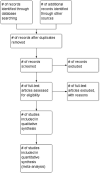Gua sha therapy for chronic low back pain: A protocol for systematic review
- PMID: 33019379
- PMCID: PMC7535769
- DOI: 10.1097/MD.0000000000020606
Gua sha therapy for chronic low back pain: A protocol for systematic review
Abstract
Background: Non-specific chronic low back pain (LBP) is a debilitating disease that profoundly impacts patients' daily physical function and quality of life. Gua sha therapy, as an easy-to-use and noninvasive complementary modality, has been widely used clinically in patients with non-specific chronic LBP. The aim of this study is to test the potential benefits and harms of gua sha therapy on patients with non-specific chronic LBP.
Methods: Ten English databases, 3 Korean databases, 6 Chinese databases, 1 Japanese database, and 2 Brazilian databases will be searched from their inception to September 2019. Randomized controlled trials will be included if gua sha therapy was used as the sole treatment or as a part of combination therapy with other treatments in patients with non-specific chronic LBP. Two reviewers will independently extract the data and assess the methodological quality using the Cochrane criteria for risk of bias. The meta-analysis will be performed using Review Manager 5.3 software.
Results: The findings of this systematic review will be published in a peer-reviewed journal.
Conclusion: This systematic review will provide more evidence regarding the clinical usage of gua sha therapy for non-specific chronic LBP.
Trial registration number: CRD42019134567.
Conflict of interest statement
The authors have no conflicts of interest to disclose.
Similar articles
-
Gua Sha therapy for chronic low back pain: A randomized controlled trial.Complement Ther Clin Pract. 2019 Feb;34:64-69. doi: 10.1016/j.ctcp.2018.11.002. Epub 2018 Nov 10. Complement Ther Clin Pract. 2019. PMID: 30712747 Clinical Trial.
-
Psychological effects of traditional Chinese mind-body exercises for low back pain: A protocol for meta-analysis.Medicine (Baltimore). 2021 Jun 4;100(22):e25605. doi: 10.1097/MD.0000000000025605. Medicine (Baltimore). 2021. PMID: 34087820 Free PMC article.
-
The effects of Gua sha on symptoms and inflammatory biomarkers associated with chronic low back pain: A randomized active-controlled crossover pilot study in elderly.Complement Ther Med. 2017 Jun;32:25-32. doi: 10.1016/j.ctim.2017.03.010. Epub 2017 Mar 21. Complement Ther Med. 2017. PMID: 28619301 Clinical Trial.
-
Effect of Scraping Therapy on Chronic Low Back Pain: A Systematic Review and Meta-analysis of Randomized Controlled Trials.J Manipulative Physiol Ther. 2021 Mar;44(3):255-270. doi: 10.1016/j.jmpt.2020.08.003. Epub 2021 Jan 9. J Manipulative Physiol Ther. 2021. PMID: 33436299
-
Therapeutic ultrasound for chronic low back pain.Cochrane Database Syst Rev. 2020 Jul 5;7(7):CD009169. doi: 10.1002/14651858.CD009169.pub3. Cochrane Database Syst Rev. 2020. PMID: 32623724 Free PMC article.
Cited by
-
Clinical and Animal Studies of Waist and Knee Scraping Therapy for Knee Osteoarthritis.Comb Chem High Throughput Screen. 2024;27(15):2278-2294. doi: 10.2174/0113862073264397231228054318. Comb Chem High Throughput Screen. 2024. PMID: 38284729 Clinical Trial.
-
Use of Acupuncture, Myofascial Release Techniques, and Kinesiology Taping to Reduce Estimated Healing Time in A Grade 3 Hamstring Strain: A Case Study.Med Acupunct. 2023 Oct 1;35(5):262-265. doi: 10.1089/acu.2023.0041. Epub 2023 Oct 17. Med Acupunct. 2023. PMID: 37900870 Free PMC article.
References
-
- Balagué F, Mannion AF, Pellisé F, et al. Non-specific low back pain. Lancet 2012;379:482–91. - PubMed
-
- Wahlgren DR, Atkinson JH, Epping-Jordan JE, et al. One-year follow-up of first onset low back pain. Pain 1997;73:213–21. - PubMed
-
- Neuhauser H, Ellert U, Ziese T. [Chronic back pain in the general population in Germany 2002/2003: prevalence and highly affected population groups]. Gesundheitswesen 2005;67:685–93. - PubMed
MeSH terms
LinkOut - more resources
Full Text Sources
Miscellaneous


